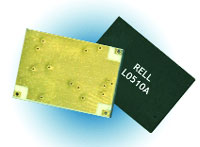
A new product family of low noise amplifiers (LNA) has been introduced that is specifically designed to increase a wireless system’s performance and reliability. The Super LNA Series LNAs are optimized to meet the design goal of achieving the lowest noise figure and best return loss simultaneously over a very wide bandwidth. These products reduce production cost and increase reliability without compromising system performance.
The Super LNA Series amplifiers cover a frequency range of 200 to 2600 MHz, which includes the VHF, UHF, CDMA, GSM, GPS, DCS, PCS, WCDMA, UMTS and MMDS bands. Typical applications include receivers, wireless data communications, and test and measurement. Table 1 lists the current models that make up the RLA series, with custom models readily available to meet customer requirements.

Key Features
Among the key features that make these amplifiers stand out are their very wide bandwidth, making them excellent for broadband RF and microwave systems, and test and measurement applications. The new amplifiers also feature an ultra-low noise figure that provides a wide dynamic range. In addition, the LNAs exhibit superior gain flatness and are unconditionally stable within their specified frequency bands making them ideal for wideband applications. All matching and decoupling components are designed in, thus there is no need for external tuning or matching, thereby reducing overall component costs and rendering the device specification the true performance of the amplifier. The amplifiers are internally matched to 50 ? and present low input and output VSWRs. Finally, they are packaged in a lead-free surface-mount package that is well suited to volume production.
A Typical Example
As an example, the model RLAS1722A is an ultra-low noise figure, wideband amplifier covering the 1700 to 2200 MHz frequency range. The amplifier offers a typical 0.55 dB noise figure, 20 dB input and output return losses, and 30 dB of gain. Its output P1dB is 19 dBm and its output third-order intercept (OIP3) is 32 dBm over the DCS, PCS, UMTS and 3G frequency bands. It is unconditionally stable and features a 50 W input and output impedance. Figures 1, 2 and 3 show the RLAS1722A amplifier’s S-parameters, noise figure and output characteristics, respectively, over its full operating frequency range.

Fig. 1 Small-signal performance at 25°C.

Fig. 2 Noise figure performance at full temperature.

Fig. 3 P1dB and OIP3 at room temperature.
The amplifier is powered by a single +5 VDC supply and draws typically 90 mA. There are built-in DC blocks at the input and output ports and built-in temperature compensation circuitry. It is supplied in a 0.5" × 0.35" × 0.08" SMT package and boasts a > 600,000 hour MTBF. The amplifier is designed to meet MIL-STD-202, MIL-STD-883 and MIL-STD-810F. A connectorized version is also available.
The other amplifier models in the series feature similar performance characteristics within their respective operating frequency ranges. Although other manufacturers are producing similar performance amplifiers, the new RLAS series amplifiers offer a distinct cost advantage over other competitive offerings.
Conclusion
A new series of Super Low Noise Amplifiers has been described that covers the 200 to 2600 MHz frequency range and offers outstanding performance over a very wide bandwidth in an unconditionally stable, low cost SMT package. These new amplifiers are ideal for wireless system applications, including receivers, data communications, and test and measurement.
Richardson Electronics Ltd., LaFox, IL
(800) 737-6937,
(630) 208-3637,
e-mail: rwc@rell.com,
www.rfwireless.rell.com.
